OPPO is a manufacturer held in especially high esteem among Western AV enthusiasts. The reasoning for this stems back to 2005, when the company released a decent upscaling DVD player, which later become an exceptional one thanks to frequent firmware updates, and a willingness to correct video processing errors pointed out by industry experts. In the years that followed, OPPO has become a trusted brand offering “no-nonsense” products backed by frequent firmware updates over a period of many years. That contrasts with the more familiar model of releasing new players each year, and requiring users to buy a brand new model to benefit from software improvements.

The BDP-103 is one of their latest Blu-ray Disc players, and sits just below the beefier BDP-105. Both products are driven by a dual-core Mediatek chip which is responsible for core video decoding, deinterlacing, scaling, and network interfacing. There is also a secondary video processor chip, Marvell’s Kyoto-G2H “Qdeo”, although it appears to be much less significant here, seeing as nearly all essential functions for accurate, true-to-source video are provided by the core chip (the Marvell chip adds optional noise reduction, and contrast and colour altering features).
The OPPO BDP-103’s biggest claim to fame – at the time of writing, at least – is that it can scale all video content to 4K (again, keep in mind that OPPO players remain current for many years, so 4K displays are likely to be more than a pipe dream while these models are current). The BDP-105EU adds high-end analogue audio circuitry for users who want to drive amplifiers in that way, whereas the BDP-103EU concentrates largely on HDMI transmission.
Like some mid-range and high-end BD players, it features dual HDMI outputs. The comparative simplicity of 1080p/24 Blu-ray playback means that it’s possible to find cheap players which produce essentially perfect AV quality (depending on the setup) if you know what to avoid, so hardware features like this are a good way to differentiate more expensive machines. The most common usage scenario for these will likely be for owners of 3D-capable HDTVs but pre-3D AV receivers, who have no intention of ditching perfectly capable audio equipment anytime soon (myself included): it’s possible to send video directly to the 3D TV but still benefit from HD audio via HDMI using the dual outputs.
More unusually, the BDP-103 features two HDMI INputs: it’s possible to send HDMI video into the OPPO BDP-103 and use it as a sort of “lite” video processor device without ever inserting a single disc into it. We can’t think of a scenario where we’d use this feature ourselves, but it’s a unique way for the company to add value – so why not? The HDMI inputs also support the (fairly mysterious) new MHL protocol, for connecting future devices such as streaming media sticks and mobile phones.
The OPPO BDP-103EU is available for £500 in the UK. Is it worth the cost when there are BD players capable of doing full justice to 1080p/24 encoded discs for much less? Let’s find out!
With a flat front finished in “brushed steel” and tiny blue and white LEDs, the BDP-103 looks considerably slicker than previous OPPO players. The disc transport is in the middle of the unit, surrounded by a glossy black material. This is not the cheap, easily scratched gloss black found on cheaper players, though. Although protected with a peel-off cover during shipping, it remarkably doesn’t seem to be too easily marred by fingerprints, giving us no reason to complain about its inclusion.
The front of the player has playback controls arranged in a “diamond” shape, with Play, Stop, Pause, and Chapter Navigation buttons. On DVD-Video discs and HDMV Blu-ray Discs, you can actually use these buttons to navigate menus. Due to BD spec reasons, that won’t work on titles authored in the BD-J mode. (Nearly everything that comes out of major studios now is authored in BD-J, while a lot of independent studios are using HDMV).
For easy access, there’s an HDMI input on the front, beside a USB input, and another one of each on the back, meaning that both accessibility and installation cleanliness are catered for.
The BDP-103 doesn’t feature inbuilt wireless connectivity, but OPPO ships the unit with a wireless USB dongle. There’s a USB port on the back of the player as well as the front, meaning that this can easily be slotted in and hidden away from view.
The player is solidly built, and feels like it will withstand many, many years of use.
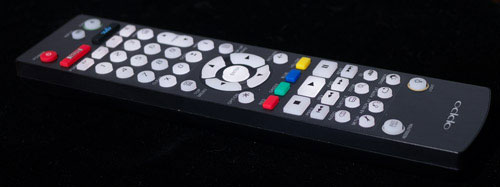
The remote control is large and brilliantly designed, and features plentiful buttons (which is nice after using players which hide some controls away deep in other menus). It has direct access to Netflix and Vudu online services, too. Best of all, the buttons are back-lit with a really slick-looking white glow.

Rear:
Front:
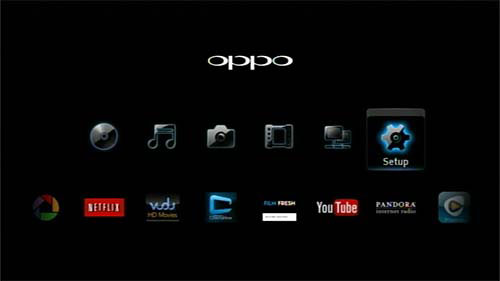
Powering the player on brings you to the OPPO home screen, which contains two rows of icons. The first shows OPPO’s own player controls, with icons relating to playback of different content types (BD/DVD movie discs, music, photos, video files, network access), and a Setup icon. The bottom row is dedicated to third-party online content, with Netflix, Picasa and YouTube being present. There are also other apps for the likes of Vudu and Best Buy Cinemanow, which won’t be usable outside of the United States (yet?), at least not without some sort of geo-filter unblocking service.
Rather than go through every single option in the Setup menu, we’ll limit discussion to the most important ones. Video Setup > Picture Adjustment lets you change image parameters for both HDMI outputs independently (it can also be called up during playback). The HDMI1 output is piped through the secondary Marvell video enhancement chip, whereas the HDMI2 output is gleaned directly from the main video decoder chip. That means that the HDMI2 output is lacking access to the picture abstracting controls (noise reduction, contrast and colour tweaks). We don’t consider that to be any loss whatsoever – although the HDMI inputs on the player perhaps mean the NR feature could be of use for making bad quality, low light camcorder footage more watchable.
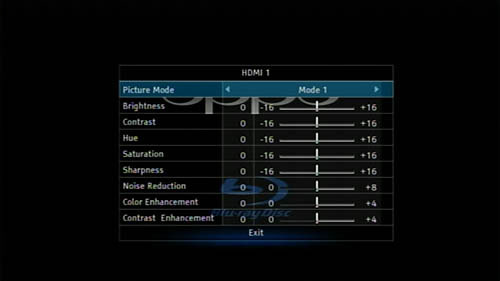
There are basic video processing controls such as Brightness, Contrast, Hue (even although it’s a digital disc player which only features digital outputs!), Saturation, and Sharpness, although we had no reason to touch these.
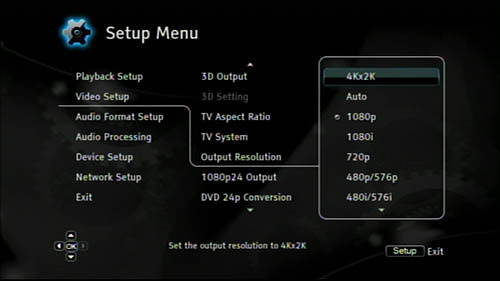
There’s an [Output Resolution] selection, with the new “4K x 2K” option appearing at the top of the list. “1080p” scales everything to 1080p, with the frame rate varying to best suit the content. There’s also still the “Source Direct” mode, which outputs content in as close to the original video format as possible (DVDs at 480i / 576i, 1080i BDs at 1080i, and so on), in case you want to send these to an external video processor for off-board scaling. (The OPPO BDP-103’s own scaling is excellent anyway, so few people will want to avoid it).
There’s also a [TV System] control, which is irrelevant for European users. The option is here for the benefit of users in the former NTSC countries who want to watch content from Europe and Australasia. TVs sold in the NTSC countries can rarely display a 50hz input, so the OPPO BDP-103EU can convert 50hz-centric content to 60hz for output. The quality is compromised compared to direct 50hz input to a compatible display, but it’s better than a blank screen, and there’s really nothing better that OPPO could be doing. On our European review unit, this came set to “PAL”, which is an incorrect choice. Choosing “NTSC” or “PAL” forces the video output to 60hz or 50hz respectively. In Europe or Australasia, where all of our HDTVs must support all frame rates if they want to bear the “HDTV” logo, there is no need to compromise the motion quality in this way, so “Multi-system” should be selected. European owners should be sure to change this setting after unboxing the player.
24p Conversion for DVD can also be enabled (we’ll investigate that later).
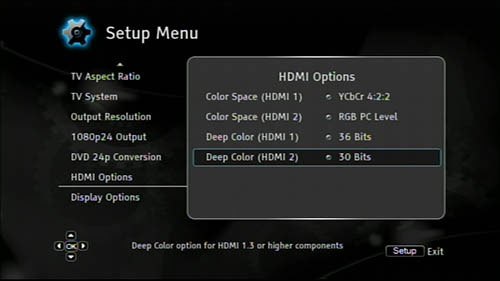
There’s an [HDMI Options] screen where the output pixel format can be selected for each of the outputs independently. Huge amounts of forum pages have gone into this subject, but the bottom line is that some displays have quirks where one input format is preferred over the other. In the vast majority of cases it should make little to no difference to chroma resolution. The [Deep Color] options meanwhile allow you to control the bit depth of both HDMI outputs independently. More signal head-room is usually good since it allows in-player picture adjustments to be done with higher precision and reduce the risk of introducing contouring to gradients, although we had no reason to touch the controls anyway.
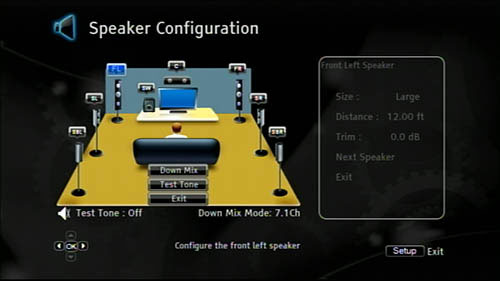
Finally, for users of the analogue surround audio outputs, the BDP-103 offers speaker management and subwoofer integration controls.
With those features out of the way, time to put our OPPO BDP-103EU review sample through its paces.
The OPPO BDP-103 excels with DVD playback. The content can only look as good as what’s been (in many cases, haphazardly) encoded, but the player does everything it can to keep DVD looking good on a large HD screen.
For NTSC content, the film mode deinterlacing works perfectly with basically any obscure cadence you can throw at the player. All of the tests on the Silicon Optix HQV Benchmark DVD passed, so there’s really little else to say on the subject other than that this is excellent for owners of large international DVD collections.
The most common type of NTSC DVD movie content is “24p” encoded with in-decoder pulldown instructions (called “Repeat Field flags”) embedded in the video stream, meaning that the actual pictures are effectively stored as 24p with instructions for backwards compatibility for 60hz output. The OPPO BDP-103 can exploit this and actually output “24p” DVD titles as real 24p. For the majority of discs, that appears to be achieved by simply ignoring the repeat field flags. OPPO’s web site states that the function
can also restore the original 24 frames per second progressive-scan video from well-authored NTSC DVDs and output 1080p 24Hz.
“Well authored DVDs” in that context will refer to those with the repeat field flags, which is nearly everything. For the rarer titles that actually have the redundant fields encoded as actual picture information (usually older discs, and a good number of those from Asian markets), the BDP-103 is set up to do its best and still attempt to pull 24p out. In our testing with these thankfully rare discs, the BDP-103EU did its best to identify the repeated frames after it had deinterlaced the video. However, if we paused playback and resumed it, the BDP-103 would produce jerky motion because we had interrupted the pulldown pattern (OPPO warns that the results might not always be perfect in the menu). From this, we can see that the 24p conversion feature on the BDP-103 is not motion adaptive, and does not deal with changes in cadence. In fact, after resuming playback and seeing jerky motion, if we paused and resumed enough times, we could get things “back into sync”. For comparison, running the same content on one of Panasonic’s BD players revealed that those recognise their error and correct it after a second or so. Still, DVDs produced in this way are rare, so it’s not much of an issue.
Strangely, with the DVD 24p Conversion feature on, the BDP-103 even attempts the same process with content that is clearly video-based, resulting in jerky motion. It’s a short trip into the menu to turn it on and off though, if you do run into trouble with some behind the scenes interviews (to give a common example) after watching a film. If you don’t care for switching, you can just leave the 24p DVD conversion mode off and watch in 60hz, like most DVD players. Perhaps OPPO could have the player switch the output to 60hz in the presence of genuine 60hz video based footage?
Of more relevance to European and Australasian readers is the PAL film mode detection. The tricky PAL 2-2 cadence is handled correctly by the OPPO BDP-103EU. It actually is possible to encode PAL movies with a Progressive structure, but nearly all PAL DVDs are encoded interlaced (which also significantly degrades encoding quality in addition to making life difficult for modern disc players), meaning that the player can’t read flags and has to perform its own analysis on the video. The BDP-103 overcomes this authoring laziness, and locks on almost instantly. Not surprisingly, it does have occasional hiccups: video-generated titles at the end of 2-2 film material (for example, a BBC show shot on video with a “film look” process, but with high motion interlaced credits at the end) can be problematic, but that’s typical for PAL film mode detection.
For non-film content, video mode deinterlacing was excellent. Judged subjectively from the Silicon Optix HQV disc, all three rotating lines appeared fairly jaggy-free, with the last line showing a fair amount of smoothness. We had no complaints whatsoever with real content, and the difficult 1080i video tests from the Spears & Munsil BD appeared as cleanly as we could possibly imagine, given the inherent limitations of interlaced video.
The actual interpolation/ scaling performance is excellent, and is a step above the Anchor Bay solution found on some older Oppo players. Analysis of an SMPTE RP133 test chart reveals very, very little ringing and a wonderfully sharp look. Sadly, that’ll be largely wasted considering that most DVD video titles have had any high frequency detail bulldozed by overdone lowpass filtering in misconfigured video encoders. The excellent quality scaling will hopefully be of most use with 1080p-to-4K scaling, assuming the algorithm being used to interpolate new pixel data is at least similar. We did take a look at some of the few unfiltered DVDs on the market on the OPPO BDP-103, and the footage could pass for a decent Blu-ray Disc in the right viewing conditions. For most other DVDs, you can’t expect that level of quality, but you can sit back safe in the knowledge that the BDP-103 is making the most of a compromised source.
Lastly, chroma: the BDP-103EU does not feature the Chroma Upsampling Error, unsurprisingly. It also filters the chroma channels with interlaced content, to disguise the inherent flaws with chroma subsampled interlaced video (the “Interlaced Chroma Problem”).
Like many players, 1080p BD titles are played back perfectly by the OPPO BDP-103, provided you have the noise reduction (and other similar controls) safely shut off. The player is delivered in this way, so is basically ready to go out of the box in this regard. OPPO should be congratulated for this: if you want to watch 1080p movie content without abstraction, all you need to do when you get the player… is do nothing (on the player end, that is)!
Compared to video formats which require deinterlacing and/or scaling (DVD being the best example), there’s comparatively little art when it comes to the design of a player that simply has to send 1080p/24 to a 1080p/24 display. That’s not to say that things can’t go wrong, but when they do, it’s usually because the manufacturers have decided to tinker with the image (Sony players have options to abstract gamma tracking; we’ve seen some Samsung units which feature undefeatable noise reduction, which seems to be a sticking point for that particular company; Panasonic players can output a totally undistorted image provided they’re set up correctly). Not surprisingly for an OPPO product, the BDP-103 is tinker-free, so if your existing BD player is also free of issues, don’t expect to plug in another trouble-free machine and and gawp at the differences, because there aren’t any. We also checked out some 3D frame-packed titles on the OPPO, and found no issues. The BDP-103EU simply reproduces what’s on the disc faithfully, and we couldn’t really ask – or want – anything more than that.
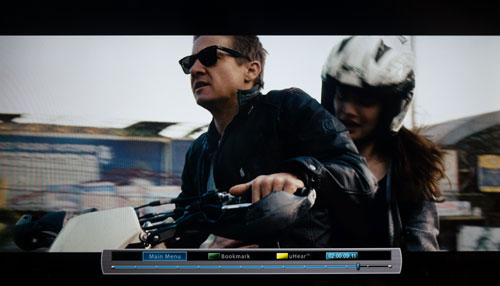
The OPPO BDP-103 preserves full dynamic range, passing blacker-than-black and whiter-than-white shades in the default configuration in our setup (menu options are there in case you own a display that favours in-player conversion to RGB, but we didn’t need to use this). There is no clipping in any of the channels. Visual inspection of luma and chroma zone plate and multiburst patterns reveals that full resolution is preserved in both, and there are also no attempts at edge enhancement (unless the viewer enables it).
Promo material for the Marvell Qdeo chip mentions a post-processing filter which smooths over tone jumps (contours) in some 8-bit video sources. As far as we can tell, OPPO has chosen not to implement this feature in the BDP-103. We made some intentionally degraded test patterns and fed them to the player, and it did not attempt to enhance the stairstepped gradient on either the HDMI1 or HDMI2 outputs, regardless of how we had the output settings configured.
At the date of first publication, we did not have a 4K display on which to test the OPPO BDP-103’s 4K upscaling. Check back over the next few weeks for our assessment of this feature.
Unsurprisingly for an OPPO product, the BDP-103 passes all of the film mode deinterlacing tests from the Spears & Munsil BD, indicating that it can avoid loss of vertical resolution on the tiny number of Blu-ray titles encoded using 1080i with unusual cadences. There was one hiccup with the Mixed Film/Video test when the credits scrolled vertically, with the video-overlaid credits losing their full motion fluidity, but given how rare 1080i content is on BD, we don’t suggest anyone loses sleep over this.
The Spears & Munsil BD doesn’t include a 2-2 film mode deinterlacing test in the 50hz refresh rate, so we used our own pattern for this. The OPPO BDP-103EU does correctly convert 1080i/50 BDs with 2-2 film cadence to 1080p correctly for live action content, although stop-motion animation (where each frame of video is not necessarily unique) can cause some problems. That content is very rare, though.
1080i/50 deinterlacing is actually quite an important test for fans of European TV content, arguably moreso than proper handling of 1080i/60, because the Blu-ray Disc spec doesn’t allow 1080p/25 to be encoded to disc directly. That means that even progressively shot 25fps material has to be encoded interlaced. (Compression features of AVC/H.264 called PAFF and MBAFF mean that the encoding quality will be just as good as a true progressive encode, providing that the encoder had these features enabled and the player correctly identifies the content, so don’t lament BD’s lack of a pure 25p mode for too long).
For readers in the US and Canada (and other 60hz countries, for that matter), the OPPO BDP-103 is one of a handful of players that will actually play back 50hz-centric BD content. Most other players sold in these countries either skip over 50hz clips on the disc, or even worse, freeze entirely. For readers in 50hz countries, this isn’t anything special, since all players must be capable of playing back all video formats in Europe.
The dual-core chip in the OPPO BDP-103 allows it to be responsive and non-frustrating to use. The only usability issue we ran into was with discs authored in the BD-J version of a certain authoring tool (mostly used for lower budget niche titles), where menu graphics could sometimes become unresponsive for a few seconds. We put the right people in touch with each other, so imagine this minor point will be fixed in a firmware update soon.
Everything else was as fast and seamless as we could hope for. BD-J titles authored in high-end professional software (most commercial releases, and most modern Hollywood titles) had absolutely no issues.
Not surprisingly, the BDP-103 handled the comparatively streamlined HDMV Interactive Graphics (menus, overlaid prompts, etc) with no difficulties whatsoever. Most titles produced by European independent studios are authored in HDMV mode.
The OPPO BDP-103 features very fast loading times, too. (The “load times” below measure the time taken from the closing of the disc tray to displaying the first video, usually a copyright warning or studio logo).
| Power on to Tray Open | 00:04 |
| Load time: Babel (HDMV) | 00:15 |
| Load time: Serenity (BD-J) | 00:16 |
| Load time: Alien (BD-J) | 00:20 |
On the European model we received from OPPO UK, Netflix video was output at 1080p/50, even when we selected “Multi-system” from the player’s setup menu. Online video is of comparatively average quality compared to what’s pulled from optical disc, but the player should not attempt frame rate conversions in any case. This meant that most shows on the service, which are in 60hz, played back with motion stuttering when the output was 50hz. From observing similar issues on “Smart TV” displays that have Netflix built in, we get the idea that Netflix isn’t attaching metadata which describes the original frame rate of the content to the device – and that’s something they should really look into as their international rollout continues.
In a worst case scenario, that means that if Netflix themselves have standards converted 50hz footage to 60hz and stored it that way on their servers, it’ll be going through another conversion step on the receiving end. We had to manually force “NTSC” in the TV System setting to avoid the last 10 frames of each second with 60hz Netflix content being dropped.
All of the optical disc players that OPPO have brought to the Western markets have been excellent, so it’s no surprise that the same is true of the BDP-103. Like many BD players, the OPPO BDP-103 dutifully reproduces 1080p/24 BD content correctly. More unusual is its excellent handling of the rarer 1080i Blu-ray titles.
Its most unique features are what set it apart. Compared to other Blu-ray players on the market, it adds 4K upscaling, outstanding build quality with a luxurious feel, analogue surround audio outputs, and even HDMI inputs. We’ll be updating this review to discuss the ultra HD upscaling and input features as soon as we get a chance.
If you own a 1080p TV, watch mainly 1080p/24 movies on Blu-ray, and feed bitstream audio to an HDMI capable AV receiver, you’ll end up with the same AV quality from cheaper players – provided you seek a “known good” one out and avoid players which inflict some whimsical alterations on the picture without the consent of the user (or the filmmaker, for that matter!)
For that reason, assigning ratings to disc players is difficult. Unlike display devices which always have various parameters to consider (and prioritise in importance), a disc player’s performance is largely decided by whether it passes or fails a multitude of tests. There is even less subjectivity involved than there is in a scientifically-minded review of a TV or projector, which is saying something.
That leaves us with the question, does the OPPO BDP-103 deserve a “Highly Recommended” or a “Reference” rating? We went with the latter in the end, because although we’ve pointed out a few small areas where the player’s usability could be improved (we know from past experience with OPPO that it’s likely they actually will be), we can’t think of any better player when you look at the overall situation. The BDP-103EU does have it all: outstanding usability, fast performance, undistorted playback of 1080p/24 Blu-ray Discs, excellent handling of trickier sources such as 1080i content and DVDs, and a very quiet disc mechanism. Add 4K upscaling, online connectivity, network playback, and top notch build quality into your consideration, and you’ll probably agree with us that the final rating is deserved.
